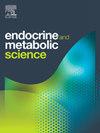CtBP: A mediator of a metabolic switch from homeostasis to carcinogenesis
Q3 Medicine
引用次数: 0
Abstract
The dimeric form of C-terminus binding protein (CtBP), which is responsible for a balanced transcription rate of genes involved in the homeostatic processes, is a global corepressor. CtBP dimerization and formation of the CtBP corepressor complex require NADH. Under a normal NADH/NAD+ ratio, CtBP is in the dimeric form while, when NADH/NAD+ decreases, it converts into a monomeric form. The monomeric form of CtBP inhibits histone acetyltransferase p300, which plays an important role in the packaging of newly replicated and repaired DNA into chromatin by acetylating the histone H3 core domain lysine 56 (H3K56). Further, by inhibiting p300, the monomeric form of CtBP inhibits NFκB, which plays an important role in the innate immune response toward neoantigens. Furthermore, NFκB causes the transcription of IL-6, which is important in the resolution of the innate immune response. Moreover, by inhibiting p300, the monomeric CtBP inhibits p53, the guardian of the genome. Thus, by inhibiting p300, the monomeric form of CtBP may be involved in carcinogenesis when NADH/NAD+ ratio decreases. In contrast, hypoxia increases the NADH/NAD+ ratio, generating the dimeric form of CtBP and relieving the inhibition of p300 by the monomeric CtBP. The higher NADH/NAD+ ratio and p300 activity under hypoxia mask the instability of cancer cells, confer invasive properties, cause COX-2 expression, increase the transactivation activity of the hypoxia-inducible factor (HIF), and cause drug resistance through NFκB. Thus, p300, regulated by NADH/NAD+ ratio through CtBP, works as a double-edged sword in cancer initiation and progression, respectively.
CtBP:从体内平衡到致癌的代谢转换的中介
二聚体形式的c端结合蛋白(CtBP)是一种全局协同抑制因子,它负责平衡参与稳态过程的基因的转录率。CtBP二聚化和CtBP协同抑制复合物的形成需要NADH。在正常NADH/NAD+比例下,CtBP呈二聚体形式,当NADH/NAD+减少时,CtBP转化为单体形式。CtBP的单体形式抑制组蛋白乙酰转移酶p300,该酶通过使组蛋白H3核心结构域赖氨酸56 (H3K56)乙酰化,在将新复制和修复的DNA包装成染色质的过程中发挥重要作用。此外,通过抑制p300,单体形式的CtBP抑制NFκB,这在针对新抗原的先天免疫应答中起重要作用。此外,NFκB引起IL-6的转录,IL-6在先天免疫应答的解决中起重要作用。此外,通过抑制p300,单体CtBP抑制p53,基因组的守护者。因此,通过抑制p300,当NADH/NAD+比值降低时,单体形式的CtBP可能参与了致癌作用。相反,缺氧增加NADH/NAD+比值,产生二聚体形式的CtBP,减轻单体CtBP对p300的抑制作用。低氧条件下较高的NADH/NAD+比值和p300活性掩盖了癌细胞的不稳定性,赋予其侵袭性,引起COX-2表达,增加缺氧诱导因子(HIF)的反激活活性,并通过NFκB引起耐药。因此,通过CtBP受NADH/NAD+比例调节的p300在癌症的发生和发展中分别发挥着双刃剑的作用。
本文章由计算机程序翻译,如有差异,请以英文原文为准。
求助全文
约1分钟内获得全文
求助全文
来源期刊

Endocrine and Metabolic Science
Medicine-Endocrinology, Diabetes and Metabolism
CiteScore
2.80
自引率
0.00%
发文量
4
审稿时长
84 days
 求助内容:
求助内容: 应助结果提醒方式:
应助结果提醒方式:


